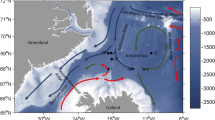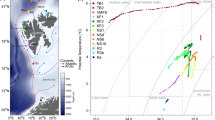Abstract
Monthly samples were collected in oceanic waters off Discovery Bay, Jamaica, in 60- and 200-m vertical hauls, using 200- and 64-μm mesh plankton nets, from June 1989 to July 1991. Length-weight regressions were derived for twelve genera of copepods (R2=0.79 to 0.97). For eight occasions spanning the study period, biomass estimates generated from these length-weight regressions differed by only 3% from direct weight determinations. The mean ash content of copepods was 7.1%, and the energy density was 20.8 kJ g-1 ash-free dry weight (AFDW). Mean annual biomass of the total copepod community in the upper 60 m was 1.83 mg AFDW m-3 (range 1.14 to 2.89 mg AFDW m-3), and for the 200-m water column was 0.96 mg AFDW m-3 (range 0.12 to 1.99 mg AFDW m-3). Estimates of generation times for five common taxa ranged from 16.1 to 33.4 d. None of the taxa investigated displayed isochronal development; in general, stage duration increased in later copepodite stages. Weight increments showed a significant decrease in later copepodite stages, but with strong reversal of the trend from stage 5 to adult female in most species. Daily specific growth rates also declined in later copepodite stages, and ranged from 1.49 d-1 in stage 1–2 Paracalanus/Clausocalanus spp. to 0.04 in stage 5-female of Oithona plumifera. Progressive food limitation of somatic copepodite growth and egg production is postulated. Naupliar production was 50.4 to 59.5% of copepodite production, and egg production was 35.1 to 27.7% of copepodite production in the 60-and 200-m water columns, respectively. Total annual copepod production, including copepodites, nauplii, eggs and exuviae, was 160 kJ m-2 yr-1 for the upper 60 m and 304 kJ m-2 yr-1 for the upper 200 m. Secondary production of the copepod community in oceanic waters off Discovery Bay approaches 50% of the corresponding value in tropical neritic waters.
Similar content being viewed by others
References
Båmstedt U (1986) Chemical composition and energy content. In: Corner EDS, O'Hara SCM (eds) The biological chemistry of marine copepods. Oxford Science Publications, Clarendon Press, Oxford, pp 1–58
Beckman BR, Peterson WT (1986) Egg production by Acartia tonsa in Long Island sound. J Plank Res 8: 917–925
Berges JA, Roff JC, Ballantyne J (1990) Relationship between body size, growth rate and maximal enzyme activity in brine shrimp, Artemia franciscana. Biol Bull mar biol Lab, Woods Hole 179: 287–296
Berggreen U, Hansen B, Kiørboe T (1988) Food size spectra, ingestion and growth of the copepod Acartia tonsa during development: implications for the determination of copepod production. Mar Biol 99: 341–352
Björnberg TS (1972) Development stages of some tropical and subtropical planktonic marine copepods. Stud Fauna Curaçao 40: 1–185
Bottger R (1987) The vertical distribution of micro- and small mesozooplankton in the central Red Sea. Biol Oceanogr (N Y) 4: 383–402
Bouchers P, Hutchings L (1987) Starvation tolerance, development time and egg production of Calanoides carinatus in the southeastern Benguela current. J Plank Res 9: 855–873
Checkley D (1980a) The egg production of a marine planktonic copepod in relation to its food supply: laboratory studies. Limnol Oceanogr 25: 430–446
Checkley D (1980b) Food limitation of egg production by a marine planktonic copepod in the sea off sourthern California. Limnol Oceanogr 25: 991–998
Chisholm LA, Roff JC (1990a) Size-weight relationships and biomass of tropical neritic copepods off Kingston, Jamaica. Mar Biol 104: 71–77
Chisholm LA, Roff JC (1990b) Abundance, growth rates, and production of tropical neritic copepods off Kingston, Jamaica. Mar Biol 106: 79–89
Clarke C, Roff JC (1990) Abundance and biomass of herbivorous zooplankton off Kingston, Jamaica, with estimates of their annual production. Estuar estl Shelf Sci. 31: 423–437
Conover RJ (1979) Secondary production as an ecological phenomenon. In: Van der Spoel S, Pierrot-Bults AC (eds) Zoogeography and diversity in plankton. Bunge Scientific Publishers, Utrecht, pp 50–86
Corkett CJ, McLaren IA, Sévigny JM (1986) The rearing of marine copepods Calanus finmarchicus (Gunnerus), C. glacialis Jaschnov and C. hyperboreus Kroyer with comment on the equiproportional rule (Copepoda). Syllogeus (Nat Mus Can) 40: 241–265
Durbin EG, Durbin AG (1978) Length-weight relationships of Acartia tonsa in Narragansett Bay, Rhode Island. Limnol Oceanogr 28: 1199–1213
Greze VN (1978) Production in animal populations. In: Kinne O (ed) Marine ecology. A comprehensive integrated treatise on life in oceans and coastal waters. Vol. IV. Dynamics. John Wiley and Sons, New York, pp 89–114
Harris RR, Paffenhöfer GA (1976) Feeding, growth and reproduction of the marine planktonic copepod Temora longicornis Muller. J mar biol Ass, UK 56: 675–690
Hart RC (1990) Copepod post-embryonic durations: pattern, conformity, and predictability. The realities of isochronal and equiproportional development, and trends in the copepodidnaupliar duration ratio. Hydrobiologia 206: 175–206
Hopcroft RR, Roff JC (1990) Phytoplankton size fractions in a tropical neritic ecosystems near Kingston, Jamaica. J Plank Res 12: 1069–1088
Huntley M, Boyd C (1984) Food-limited growth of marine zooplankton. Am Nat 124: 455–477
Ianora A, Buttino I (1990) Seasonal cycles in population abundances and egg production rates in the planktonic copepods Centropages typicus and Acartia clausi. J Plank Res 12: 473–481
Kimoto K, Uye S, Onbé T (1986) Egg production of a brackish-water calanoid copepod Sinocalanus tenellus in relation to food abundance and temperature. Bull Plankton Soc Japan 33: 133–145
Klein Breteler WCM, Fransz HG, Gonzalez SR (1982) Growth and development of four calanoid copepod species under experimental and natural food conditions. Neth J Sea Res 16: 195–207
Landry MR (1978) Population dynamics and production of a planktonic copepod, Acartia clausi, in a small temperate lagoon on San Juan Island, Washington, Int Rev ges Hydrobiol 63: 77–119
Landry MR (1983) The development of marine calanoid copepods with comment on the isochronal rule. Limnol Oceanogr 28: 614–624
Le Borgne R (1982) Zooplankton production in the eastern tropical Atlantic Ocean: net growth efficiency and P:B in terms of carbon, nitrogen and phosphorus. Limnol Oceanogr 27: 681–698
Lewis JB, Fish AG (1969) Seasonal variation of the zooplankton fauna of surface waters entering the Caribbean Sea at Barbados. Caribb J Sci 9: 1–21
Li WKW, Subba Rao DV, Harrison WG, Smith JC, Cullen JJ, Irwin B, Platt T (1983) Autotrophic picoplankton in the tropical ocean. Science, NY 219: 292–295
Longhurst AR (1984) Importance of measuring rates and fluxes in marine ecosystems. In: Fasham MJR (ed) Flows of energy and materials in marine ecosystems. Theory and practice. Plenum Press, New York, pp 3–22
Longhurst AR (1985) The structure and evolution of plankton communities. Prog Oceanogr 15: 1–35
Longhurst AR, Pauly D (1987) Ecology of tropical oceans. Academic Press, New York
Malone TC (1971) The relative importance of nanoplankton and netplankton as primary producers in tropical oceanic and neritic phytoplankton communities. Limnol Oceanogr 16: 633–639
McLaren I (1978) Generation lengths of some temperate marine copepods: estimation, production and implications. J Fish Res Bd Can 35: 1330–1342
McLaren I, Corkett CJ (1981) Temperature dependent growth and production by a marine copepod. J Fish Res Can 38: 77–83
McLaren I, Tremblay MJ, Corkett CJ, Roff JC (1989) Copepod production on the Scotian Shelf based on life history analyses and laboratory rearings. Can J Fish aquat Sciences 46: 560–583
Moore EA (1949) The zooplankton of the upper waters of the Bermuda area of the North Atlantic. Bull Bingham oceanogr Coll 12: 1–97
Moore EA (1967) A study of the zooplankton in the Caribbean Sea off Jamaica. PhD thesis, McGill University, Montreal
Moore EA, Sander F (1977) A study of the offshore zooplankton of the tropical western Atlantic near Barbados. Ophelia 16: 77–96
Moore EA, Sander F (1979) A comparative study of zooplankton from oceanic and harbour waters of Jamaica. Biotropica 11: 196–208
Mullin MM, Brooks ER (1970a) Growth and metabolism of two planktonic marine copepods as influenced by temperature and type of food. In: Steele JH (ed) Marine food chains. Oliver and Boyd, Edinburgh, pp 74–95
Mullin MM, Brooks ER (1970b) Effect of concentration of food on body weight, cumulative ingestion, and rate of growth of the marine copepod Calanus helgolandicus. Limnol Oceanogr 15: 748–755
Nassogne A (1970) Influence of food organisms on the development and culture of pelagic copepods. Helgoländer wiss Meeresunters 20: 333–345
Paffenhöfer G-A (1976) Feeding, growth and food conversion of the marine planktonic copepod, Calanus helgolandicus. Limnol Oceanogr 21: 39–50
Peterson WT (1986) Development, growth and survivorship of the copepod Calanus marshallae in the laboratory. Mar Ecol Prog Ser 29: 61–72
Peterson WT, Tiselius P, Kiørboe T (1991) Copepod egg production, moulting and growth rates, and secondary production, in the Skagerrak in August 1988. J Plank Res 13: 131–154
Phillipson J (1964) A miniature bomb calorimeter for small biological samples. Oikos 15: 130–139
Raymont JEG (1983) Plankton and productivity in the oceans. Vol. 2. Zooplankton. Pergamon Press, Oxford
Razouls S (1977) Analyse pondérale, élémentarire et calorimétrique des stades juvéniles de copépodes pélagiques au cours d'une année. J exp mar Biol Ecol 26: 265–273
Rigler FH, Downing JA (1984) The calculation of secondary production. In: Downing JA, Rigler FH (eds) A manual on the methods for the assessment of secondary production in fresh waters, 2nd edn. Blackwell Scientific Publications, Oxford, pp 19–58
Roff JC, Hopcroft RR (1986) High precision microcomputer based measuring system for ecological research. Can J Fish aquat Sciences 43: 2044–2048
Roff JC, Turner JT, Webber MK, Hopcroft RR (1995). Bacterivory by tropical copepod nauplii: extent and possible significance. Aquat microb Ecol (in press)
Sazhina LI (1980) Fecundity, growth rate and specific production of some copepods of the Atlantic ocean. Soviet J mar Biol 6: 154–159
Sciandra A, Gouze JL, Nival P (1990) Modelling the reproduction of Centropages typicus (Copepoda: Calanoida) in a fluctuating food supply: effect of adaptation. J Plank Res 12: 549–572
Tester P, Turner JT (1990) How long does it take copepods to make eggs. J exp mar Biol Ecol 141: 169–182
Turner JT (1985) Zooplankton feeding ecology: contents of faecal pellets of the copepod Undinula vulgaris from continental shelf waters of the Gulf of Mexico. Mar Biol 7: 1–14
Uye S-I (1981) Fecundity studies of neritic calanoid copepods Acartia clausi Giesbrecht and A. steueri Simirnov: a simple empirical model of daily egg production. J exp mar Biol Ecol 50: 255–271
Vidal J (1980a) Physioecology of zooplankton. 1. Effects of phytoplankton concentration, temperature and body size on the growth rate of Calanus pacificus and Pseudocalanus sp. Mar Biol 56: 111–134
Vidal J (1980b) Physioecology of zooplankton. 2. Effects of phytoplankton concentration, temperature and body size on the development and moulting rates of Calanus pacificus and Pseudocalanus sp. Mar Biol 56: 135–146
Webber MK, Roff JC (1995) Annual structure of the copepod community, and its associated pelagic environment, off Discovery Bay, Jamaica. Mar Biol 123: 467–479
Williamson P, Gribbin J (1991) How plankton change the climate. New Scient 129: 48–52
Author information
Authors and Affiliations
Additional information
Communicated by R.J. Thompson, St. John's
Rights and permissions
About this article
Cite this article
Webber, M.K., Roff, J.C. Annual biomass and production of the oceanic copepod community off Discovery Bay, Jamaica. Marine Biology 123, 481–495 (1995). https://doi.org/10.1007/BF00349227
Received:
Accepted:
Issue Date:
DOI: https://doi.org/10.1007/BF00349227




